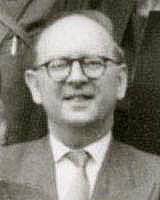Informatics Educational Institutions & Programs
Contents
Léon Rosenfeld | |
|---|---|
 Rosenfeld in 1963 | |
| Born | 14 August 1904 Charleroi, Belgium |
| Died | March 23, 1974 (aged 69) |
| Citizenship | Belgium |
| Alma mater | University of Liège (PhD, 1926) |
| Known for | Belinfante–Rosenfeld stress–energy tensor, coined the term lepton |
| Spouse | Yvonne Cambresier |
| Children | Andrée, Jean |
| Awards | Francqui Prize (1949) |
| Signature | |
 | |
Léon Rosenfeld (French: [ʁɔzɛnfɛld]; 14 August 1904 in Charleroi – 23 March 1974[1]) was a Belgian physicist and Marxist.
Rosenfeld was born into a secular Jewish family. He was a polyglot who knew eight or nine languages and was fluent in at least five of them.[2]
Rosenfeld obtained a PhD at the University of Liège in 1926, and he was a close collaborator of the physicist Niels Bohr. Rosenfeld published in 1930 the first systematic Hamiltonian approach to Lagrangian models that possess a local gauge symmetry, which predates by two decades the work by Paul Dirac and Peter Bergmann.[3] Rosenfeld contributed to a wide range of physics fields, from statistical physics and quantum field theory to astrophysics.[2] Along with Frederik Belinfante, he derived the Belinfante–Rosenfeld stress–energy tensor. He also founded the journal Nuclear Physics and coined the term lepton.[4]
In 1933, Rosenfeld married Yvonne Cambresier, who was one of the first women to obtain a Physics PhD from a European university. They had a daughter, Andrée Rosenfeld (1934–2008) and a son, Jean Rosenfeld.[5]
Awards and honors
Rosenfeld held chairs at multiple universities: Liège, Utrecht, Manchester, and Copenhagen.[2]
In 1949 Léon Rosenfeld was awarded the Francqui Prize for Exact Sciences.[2]
Works
- Rosenfeld, Léon (1948). Nuclear Forces. North-Holland.
- Rosenfeld, Léon (1951). Theory Of Electrons. North-Holland.
- Bohr, Niels; Rosenfeld, Léon (1933). "Zur Frage der Messbarkeit der elektromagnetischen Feldgrössen" [On the Question of the Measurability of Electromagnetic Field Quantities]. Royal_Danish_Academy_of_Sciences_and_Letters (in German): 123–166 – via Translated from German (1996) Niels Bohr Collected Works. Vol. 7. North–Holland: Amsterdam. Demonstrated the logical consistency of quantum electrodynamics.
References
- ^ Léon Rosenfeld's Marxist defense of complementarity, by Anja Skaar Jacobsen "Archived copy" (PDF). Archived from the original (PDF) on 17 July 2011. Retrieved 17 July 2011.
{{cite web}}: CS1 maint: archived copy as title (link) - ^ a b c d Jacobsen, Anja Skaar (2012). Léon Rosenfeld: Physics, Philosophy, and Politics in the Twentieth Century. doi:10.1142/7776. ISBN 978-981-4307-81-9.
- ^ Leon Rosenfeld and the challenge of the vanishing momentum in quantum electrodynamics, by Donald Salisbury [1]
- ^ Rosenfeld, Léon (1948). Nuclear Forces. Interscience Publishers, New York, xvii.
- ^ Smith, Claire. "Andree Jeanne Rosenfeld (1934–2008)". Retrieved 28 November 2015.
External links
 Media related to Léon Rosenfeld at Wikimedia Commons
Media related to Léon Rosenfeld at Wikimedia Commons- Oral history interview transcript for Léon Rosenfeld on 3 September 1968, American Institute of Physics, Niels Bohr Library & Archives

















